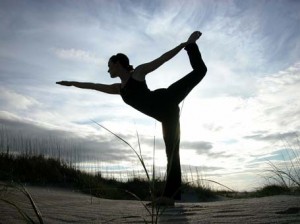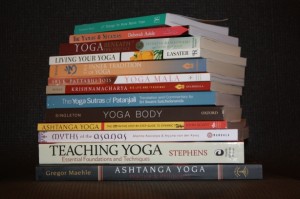Ensuring Success in Your Practice
I’ve put together a few tips that I feel will help new students in ensuring they get the most out of a yoga practice. I use the word “new” lightly, as I still learn something new every time I’m on the mat. The audience that I’m writing this for is students who recently discovered an asana practice or are considering getting into hatha yoga and instructors who may find something of value in these points.
Suspending Expectations
Do yoga because you want to do yoga, not for any other reason. I mention this for two reasons. One, if something does transform or manifest in your life due to your yoga experience, you may miss it if you sights are set on an expectation that may or may not happen. Two, if you are set in the expectation of something to manifest from your practice, then you’re kind of out of alignment with the spirit of yoga. To say this logically, If the right means are used with the wrong intention, then the right means yield the wrong results.
Goals
Yoga is not a means to an end but that does not mean that you can’t have goals with your practice. You will often hear that hatha yoga is not a competition or wherever you are in your practice is exactly where you need to be. But I have never found anything wrong with setting a goal in an asana practice. Whatever goal you set, respect the foundation you will need to develop to achieve that goal. If you have your eye on notoriously beautiful natarajasana, consider developing a strong foundation for balance with work in tree pose or warrior III. When you’re setting goals, remember that they are simply goals, and in time you will reach them, then surpass them and likely set your hopes on something more challenging. Don’t get frustrated if it takes weeks, months or years to achieve. You will get there. Eventually.
Importance of Basics
If you’re completely new to hatha yoga, try not to get too frustrated with correct form, or the responsible teachers that are constantly correcting you. I still get corrected by instructors in Adho Mukha Savasana even after years of dedicated practice. Initially, correct form is something great to focus on because you can’t build a successful practice on poor form. Respecting the basics of asana will also help prevent injury. Sometimes immediate injury and sometimes long term. Some teachers are down with the philosophy of “do what feels right with your body”, but even poses that feel right initially, can become a problem later in your practice. I would highly recommend keeping an anatomy book around to know what is going on under the skin in some of the poses. Leslie Kaminoff’s book, “Yoga Anatomy” is an excellent affordable resource for your practice. I consider it to be as equally important as my yoga mat.
Committing
If you do hatha yoga once or twice and decide you want to make a dedicated practice of it, it’s quite important to commit to it. I’ve discussed this topic with some of my teachers and it seems that in order to do hatha yoga enough to reap the benefits and make it part of your lifestyle, one should do yoga at least three times a week. That number is not set in stone, but its frequent enough to maintain flexibility and the openings you work so hard to develop. Style, duration, intensity are all important second to the frequency of your practice in terms of committing. A good friend of mine that teaches a gentle style of yoga for the elderly expressed that an asana practice should include manipulating each joint through it’s full range of motion and such is sufficient to keep the body mobile and the muscles supple and that three days a week is enough to reap the benefits of yoga. Your level of commitment is completely up to you and you’re allowed to be flexible with it. But it is important to remember to have patience with the body in your practice. The muscles and joints will adapt to your practice overtime. With commitment you will get stronger, more flexible and cultivate more stamina. Just remember to have patience with the process as some effects are subtle and may not be noticeable initially and others take time. Resting, healing, restoring and if needed, taking time off, is important as well. Don’t forsake the restorative aspect.
Journey Wisely
If you have plans for your practice and are a goal oriented person, carefully determine the direction you are headed. It’s fine to set a logical plan, but remember to be flexible and open minded. Some of the most awesome places yoga has taken me, transported me there by saying yes to something I would normally expect myself to say no to. Don’t be surprised to be coaxed out of your comfort zone in yoga, but please do embrace your voice of reason. If it seems wrong, weird, tacky or harmful, then it’s probably not appropriate for you. If you’re setting goals or making plans of yoga, consider the pre-requisites and also consider that the path you are on is a journey, there could be plenty of detours, summits, peaks, valleys, stormy seas and sunny days that you have yet to consider. Embrace them all with a pure heart, aware mind, and suspended judgment.
Know your Body
Get to know your body. Love your body as it is. Love your body as it changes. I think we’re all working on this one constantly. We have the media and Photoshop to thank for that. Practice with your awareness beneath the skin. focus your intention on the inside and how you feel, not how you look. We reach for the external beauty of the asanas, but the composure of the poses comes from the inside from your intention and expression. If your studio has mirrors, use them to ensure you have proper form (yes your butt is still back there, and it’s the same size it was this morning). A great tip is to practice with closed eyes for remaining internal and cultivating awareness of your body as well as providing an escape from environments that are too visually stimulating, or if you’re practicing too close for comfort to others.
Stretch Before Class
I know, it seems redundant, but it helps and can also prevent injury. One of my fellow students shared this tip with me when she said that we often go from sitting, to standing, then into a deep lunge with little to no stretching in between. A runner’s lunge is a really deep stretch. It’s one that I have to surrender to slowly and with awareness before I’m open enough to perform asanas like crescent lunge, warrior or side angle. If you arrive a few minutes before class starts, take advantage of this time to do a quick self-assessment find your tight spots and create the openings required for a safe hatha session. This may not seem that important, as you see many people just sitting in sukhasana waiting for class to start, but please do pre-stretching if you’re one of us who have to sit at a desk all day or if you have a long drive to class.
Get your Feet Wet
Everything I have mentioned so far pertains to a hatha yoga practice. As you begin to mix and mingle with other yogis you will find that there is more to yoga than putting your body through the paces. Bhakti yoga (devotional worship)is becoming more popular in the west as is Jnana yoga (meditation). If you already have a form of devotional practice, it’s ok to embrace it in hatha. It doesn’t have to be publicized or announced to anyone to be reinforced by your practice. The strength that you gain from hatha is not just physical. You gain emotional and mental strength rooted in clarity and focus as you begin to safely play with your perceived boundarie. Aside from what you can experience directly, there is much history, philosophy and culture that can be studied in relation to yoga. If you love devotional worship, you may find heart opening stories in the Bhagavad Gita, or if you’re a fan of musing the mechanics behind existence, the Vedanta will amaze you at how early civilization recorded and expressed their own wonder with the universe and how it parallels with the same amazement we have today. Explore and learn. There is so much more to yoga than what we initially see on the surface.
These are just a few things that helped me when I was new to the mat and I learn more things every day from fellow students and my wonderful teachers. I still embrace every one of these points today. I still set goals within and outside of my practice, I take beginners classes often to keep experiencing the basics and reinforcing good form. I suspend judgment of a style or a teacher’s technique so that I’m not too close-minded to learn something new or different methods of something I already practice. I have had to turn down many happy hour invitations from co-workers and friends to stay committed to my hatha routine and have foregone sleeping in on many Saturday mornings to make it to a weekend class or workshop. I also forgive myself for having extremely tight shoulders, old sports injuries, an excessive lower back curve and high hip bones. These are just a few examples of how much I owe some of my excellent teachers for helping me make my practice a success. I hope that you’re able to use something from my experiences to ensure the same for yours.
by – Scott Kilpatrick

